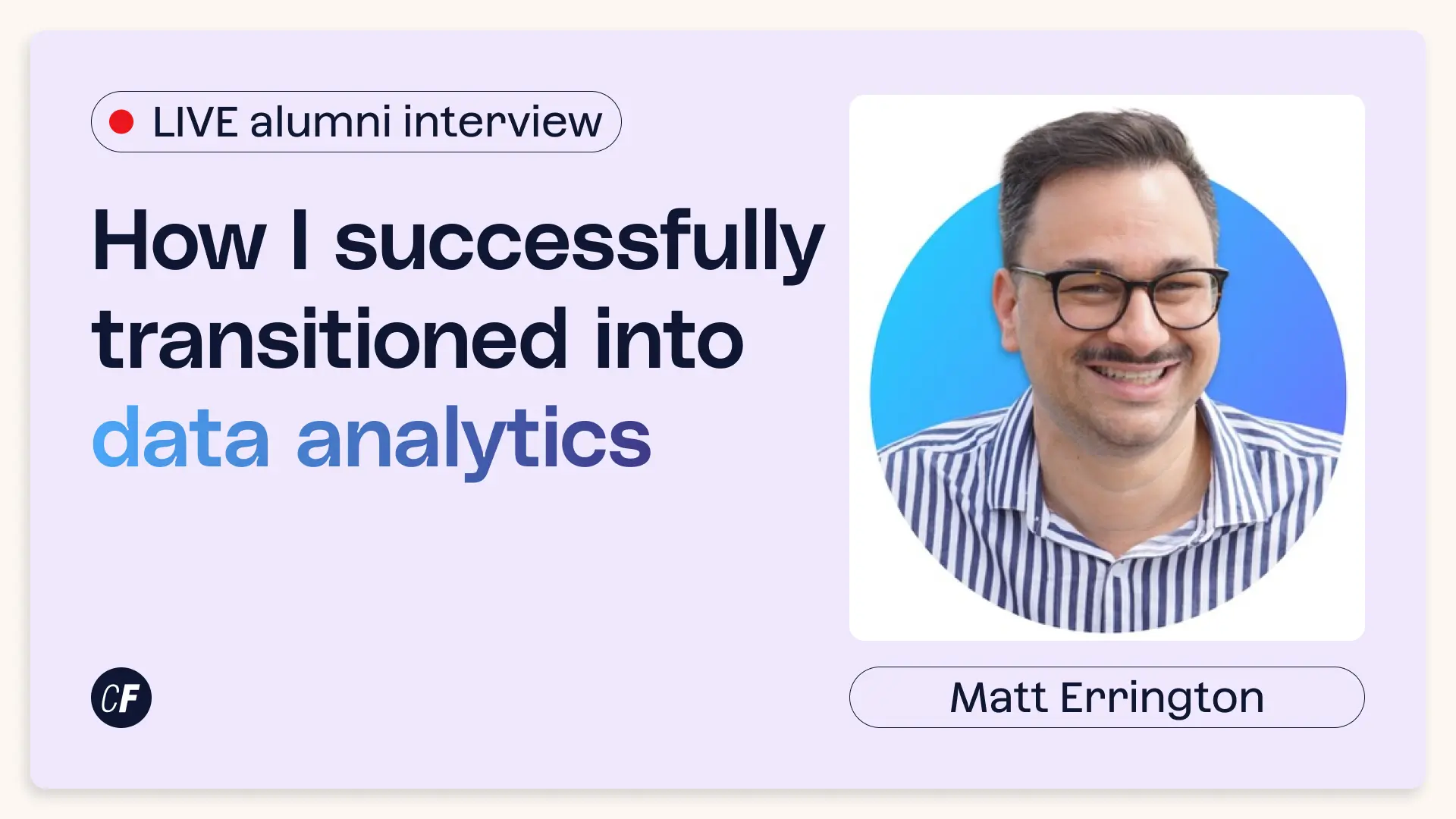Data Analytics
What is data analytics?
Data analytics is the process of turning raw data into meaningful, actionable insights. You can think of it as a form of business intelligence, used to solve specific problems and challenges within an organization. It’s all about finding patterns in a dataset which can tell you something useful and relevant about a particular area of the business—how certain customer groups behave, for example, or why sales dipped during a given time period.
A data analyst takes the raw data and analyzes it to draw out useful insights. They then present these insights in the form of visualizations, such as graphs and charts, so that stakeholders can understand and act upon them. The kinds of insights gleaned from the data depends on the type of analysis performed. There are four main types of analysis used by data experts:
- descriptive
- diagnostic
- predictive
- prescriptive
Descriptive analytics looks at what happened in the past, while diagnostic analytics looks at why it might have happened. Predictive and prescriptive analytics consider what is likely to happen in the future and, based on these predictions, what the best course of action might be.
In all, data analytics helps you to make sense of the past and to predict future trends and behaviors. So, rather than basing your decisions and strategies on guesswork, you’re making informed choices based on what the data is telling you. With a data-driven approach, businesses and organizations are able to develop a much deeper understanding of their audience, their industry, and their company as a whole—and, as a result, are much better equipped to make decisions, plan ahead, and compete in their chosen market.
What is data analytics used for?
Any organization collecting data can make use of data analytics, and how it’s used will vary depending on the context. Broadly speaking, data analytics is used to drive smarter business decisions. This helps to reduce overall business costs, to develop more effective products and services, and to optimize processes and operations across an organization.
In more specific terms, data analytics might be used to predict future sales and purchasing behaviors, for example by identifying trends from the past. It might be used for security purposes, for example to detect, predict, and prevent fraud, especially within the insurance and finance industries. It can be used to evaluate the effectiveness of marketing campaigns, and to drive more accurate audience targeting and personalization. In the healthcare sector, data analytics can be used to make faster, more accurate diagnoses and to identify the most suitable treatment or care for each individual patient. Data analytics is also used to optimize general business operations, for example by identifying and eliminating bottlenecks within certain processes.
Data analytics is used in almost every industry—from marketing and advertising to education, healthcare, travel, transport and logistics, finance, insurance, media and entertainment. Think of the personalized recommendations you get from the likes of Netflix and Spotify; that’s all down to data analytics. You can learn more about how data analytics is applied in the real world here.
What is the typical data analysis process?
The data analysis process can be broken down into five steps: Defining the question, collecting the data, cleaning the data, analyzing it, and creating visualizations and sharing insights.
Defining the question
The first step in the process is to define a clear objective. Before delving into the data, you’ll come up with a hypothesis you want to test, or a specific question you want to answer. For example, you might want to investigate why so many customers unsubscribed from your email newsletter in the first quarter of the year. Your problem statement or question will inform what data you analyze, where you pull it from, and the type of analysis you carry out.
Collecting the data
With a clear objective in mind, the next step is to gather the relevant data. You might get your data from an internal database or from an external source—it all depends on your goals.
Cleaning the data
Next, you’ll prep the data for analysis, removing anything that might distort how the data is interpreted—such as duplicates, anomalies, or missing data points. This can be a time-consuming task, but it’s a crucial step.
Analyzing the data
This is where you start to draw insights from your data. How you analyze the data depends on the question you’re asking and the kind of data you’re working with, and there are many different techniques at your disposal—like regression analysis, cluster analysis, and time-series analysis (to name just a few).
Creating visualizations and sharing insights
The final step is where data is transformed into valuable insights and action points. You’ll present your findings in the form of charts and graphs, for example, and share them with key stakeholders. At this stage, it’s important to explain what the data tells you in relation to your original question. You’ll find a complete guide to data visualization in this guide.
What does a data analyst do?
Most companies are collecting masses of data all the time—but, in its raw form, this data doesn’t really mean anything. A data analyst essentially translates raw data into something meaningful and presents it in a way that’s easy for everyone to understand. As such, data analysts have a crucial role to play in any organization, using their insights to drive smarter business decisions.
Data analysts are employed across a wide variety of industries, and the role can vary quite considerably from one company to the next. For example, the typical day of a data analyst working in the medical sector will be very different to that of an analyst at an insurance brokerage. This variety is part of what makes data analytics such an interesting career path.
With that said, most data analysts are responsible for collecting data, performing analyses, creating visualizations, and presenting their findings.
So what does this look like in terms of day-to-day tasks? Some typical data analyst responsibilities include:
- Meeting with key stakeholders to understand business requirements and objectives
- Maintaining databases and establishing data processes
- Defining criteria for data quality
- Working with business stakeholders to define success metrics
- Collecting data from both internal and external sources
- Data cleansing
- Conducting different types of analysis using dedicated programs and tools
- Producing visualizations, such as graphs and charts
- Presenting findings to key stakeholders
- Advising on the best course of action
Ultimately, data analysts help organizations to understand the data they collect and how it can be used to make informed decisions. You can learn more about what it’s like to work as a data analyst in this day-in-the-life account.
How can you become a data analyst?
Data analysts tend to have an affinity for numbers and a passion for problem-solving. Besides these intrinsic qualities, the key hard and soft skills needed to become a data analyst can all be learned and transferred—you don’t need a specific degree or a particular background.
If you’re thinking about becoming a data analyst, there are several things you’ll need to do. First and foremost, you’ll need to master the necessary hard skills and industry tools. This includes getting to grips with Excel, data visualization tools such as Tableau, and in some cases, querying and programming languages such as SQL and Python. You’ll need to learn about the different types of data analysis and how to apply them, and you’ll need to become well-versed in the data analysis process—from defining a problem statement, right through to presenting your insights to key stakeholders.
At the same time, you’ll need to start building your professional data analytics portfolio. Your portfolio showcases projects you’ve worked on and provides insights into how you work as a data analyst. This is crucial for showing employers that you’ve acquired the necessary knowledge and skills to work in the field.
Data analysts are in high demand, and a career in the field is varied, financially rewarding, and highly fulfilling—your work as a data analyst will have a real, tangible impact on the business or organization. One of the most effective routes into the industry is through a dedicated program or course. With a structured, project-based curriculum, the guidance of a mentor, and the support of fellow career-changers, anyone can retrain as a data analyst. If you are thinking about becoming a data analyst, take a look at this comparison of the best data analytics certification programs on the market right now.
If you’d like to learn more about becoming a data analyst, check out these resources:
What is data analytics?
Data analytics is the process of turning raw data into meaningful, actionable insights. You can think of it as a form of business intelligence, used to solve specific problems and challenges within an organization. It’s all about finding patterns in a dataset which can tell you something useful and relevant about a particular area of the business—how certain customer groups behave, for example, or why sales dipped during a given time period.
A data analyst takes the raw data and analyzes it to draw out useful insights. They then present these insights in the form of visualizations, such as graphs and charts, so that stakeholders can understand and act upon them. The kinds of insights gleaned from the data depends on the type of analysis performed. There are four main types of analysis used by data experts:
- descriptive
- diagnostic
- predictive
- prescriptive
Descriptive analytics looks at what happened in the past, while diagnostic analytics looks at why it might have happened. Predictive and prescriptive analytics consider what is likely to happen in the future and, based on these predictions, what the best course of action might be.
In all, data analytics helps you to make sense of the past and to predict future trends and behaviors. So, rather than basing your decisions and strategies on guesswork, you’re making informed choices based on what the data is telling you. With a data-driven approach, businesses and organizations are able to develop a much deeper understanding of their audience, their industry, and their company as a whole—and, as a result, are much better equipped to make decisions, plan ahead, and compete in their chosen market.
What is data analytics used for?
Any organization collecting data can make use of data analytics, and how it’s used will vary depending on the context. Broadly speaking, data analytics is used to drive smarter business decisions. This helps to reduce overall business costs, to develop more effective products and services, and to optimize processes and operations across an organization.
In more specific terms, data analytics might be used to predict future sales and purchasing behaviors, for example by identifying trends from the past. It might be used for security purposes, for example to detect, predict, and prevent fraud, especially within the insurance and finance industries. It can be used to evaluate the effectiveness of marketing campaigns, and to drive more accurate audience targeting and personalization. In the healthcare sector, data analytics can be used to make faster, more accurate diagnoses and to identify the most suitable treatment or care for each individual patient. Data analytics is also used to optimize general business operations, for example by identifying and eliminating bottlenecks within certain processes.
Data analytics is used in almost every industry—from marketing and advertising to education, healthcare, travel, transport and logistics, finance, insurance, media and entertainment. Think of the personalized recommendations you get from the likes of Netflix and Spotify; that’s all down to data analytics. You can learn more about how data analytics is applied in the real world here.
What is the typical data analysis process?
The data analysis process can be broken down into five steps: Defining the question, collecting the data, cleaning the data, analyzing it, and creating visualizations and sharing insights.
Defining the question
The first step in the process is to define a clear objective. Before delving into the data, you’ll come up with a hypothesis you want to test, or a specific question you want to answer. For example, you might want to investigate why so many customers unsubscribed from your email newsletter in the first quarter of the year. Your problem statement or question will inform what data you analyze, where you pull it from, and the type of analysis you carry out.
Collecting the data
With a clear objective in mind, the next step is to gather the relevant data. You might get your data from an internal database or from an external source—it all depends on your goals.
Cleaning the data
Next, you’ll prep the data for analysis, removing anything that might distort how the data is interpreted—such as duplicates, anomalies, or missing data points. This can be a time-consuming task, but it’s a crucial step.
Analyzing the data
This is where you start to draw insights from your data. How you analyze the data depends on the question you’re asking and the kind of data you’re working with, and there are many different techniques at your disposal—like regression analysis, cluster analysis, and time-series analysis (to name just a few).
Creating visualizations and sharing insights
The final step is where data is transformed into valuable insights and action points. You’ll present your findings in the form of charts and graphs, for example, and share them with key stakeholders. At this stage, it’s important to explain what the data tells you in relation to your original question. You’ll find a complete guide to data visualization in this guide.
What does a data analyst do?
Most companies are collecting masses of data all the time—but, in its raw form, this data doesn’t really mean anything. A data analyst essentially translates raw data into something meaningful and presents it in a way that’s easy for everyone to understand. As such, data analysts have a crucial role to play in any organization, using their insights to drive smarter business decisions.
Data analysts are employed across a wide variety of industries, and the role can vary quite considerably from one company to the next. For example, the typical day of a data analyst working in the medical sector will be very different to that of an analyst at an insurance brokerage. This variety is part of what makes data analytics such an interesting career path.
With that said, most data analysts are responsible for collecting data, performing analyses, creating visualizations, and presenting their findings.
So what does this look like in terms of day-to-day tasks? Some typical data analyst responsibilities include:
- Meeting with key stakeholders to understand business requirements and objectives
- Maintaining databases and establishing data processes
- Defining criteria for data quality
- Working with business stakeholders to define success metrics
- Collecting data from both internal and external sources
- Data cleansing
- Conducting different types of analysis using dedicated programs and tools
- Producing visualizations, such as graphs and charts
- Presenting findings to key stakeholders
- Advising on the best course of action
Ultimately, data analysts help organizations to understand the data they collect and how it can be used to make informed decisions. You can learn more about what it’s like to work as a data analyst in this day-in-the-life account.
How can you become a data analyst?
Data analysts tend to have an affinity for numbers and a passion for problem-solving. Besides these intrinsic qualities, the key hard and soft skills needed to become a data analyst can all be learned and transferred—you don’t need a specific degree or a particular background.
If you’re thinking about becoming a data analyst, there are several things you’ll need to do. First and foremost, you’ll need to master the necessary hard skills and industry tools. This includes getting to grips with Excel, data visualization tools such as Tableau, and in some cases, querying and programming languages such as SQL and Python. You’ll need to learn about the different types of data analysis and how to apply them, and you’ll need to become well-versed in the data analysis process—from defining a problem statement, right through to presenting your insights to key stakeholders.
At the same time, you’ll need to start building your professional data analytics portfolio. Your portfolio showcases projects you’ve worked on and provides insights into how you work as a data analyst. This is crucial for showing employers that you’ve acquired the necessary knowledge and skills to work in the field.
Data analysts are in high demand, and a career in the field is varied, financially rewarding, and highly fulfilling—your work as a data analyst will have a real, tangible impact on the business or organization. One of the most effective routes into the industry is through a dedicated program or course. With a structured, project-based curriculum, the guidance of a mentor, and the support of fellow career-changers, anyone can retrain as a data analyst. If you are thinking about becoming a data analyst, take a look at this comparison of the best data analytics certification programs on the market right now.
If you’d like to learn more about becoming a data analyst, check out these resources:
All articles

7 Best Data Warehouse Tools to Explore in 2025

8 of the Best Data Analyst Courses in Germany & How You Could Take Them for Free

What is Augmented Analytics? A Beginner’s Guide

Catastrophic Forgetting, Hallucinating, Poisoned Models…Is AI OK?

Human-in-the-Loop in AI & Machine Learning: An Introduction

12 Machine Learning Skills to Power Your Career

6 Hot Data Trends and Predictions for 2025

Becoming a Sustainability Analyst: How to Do it in 2025

How To Use AI To Empower Your Data Analytics Workflow
Read more articles >

How Sara Became a UX Designer at the BBC With CareerFoundry

How to Break into Product Management: A Career Change Guide

How to Start a Digital Marketing Career: A Student Success Story with CareerFoundry

Career Change with a Bildungsgutschein: How Adi Became a Data Analyst for Free
Read more articles >

How to Break into Product Management: A Career Change Guide

How to Start a Digital Marketing Career: A Student Success Story with CareerFoundry

Career Change with a Bildungsgutschein: How Adi Became a Data Analyst for Free

How CareerFoundry Helped a Historian Transition into Data Analytics
Read more articles >










